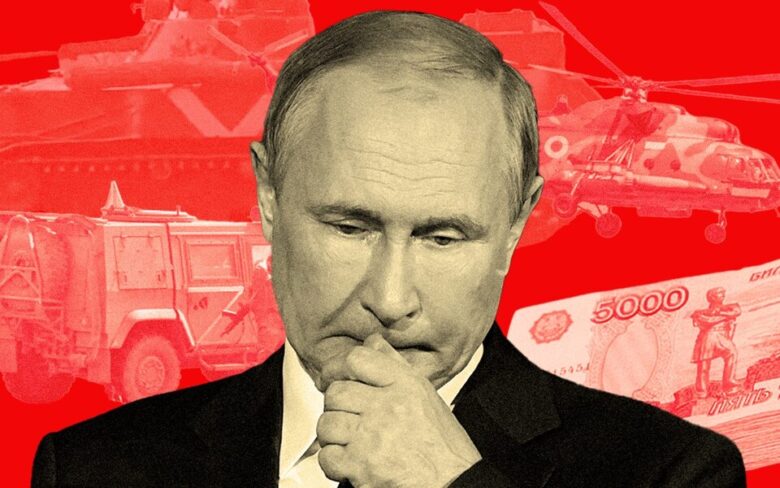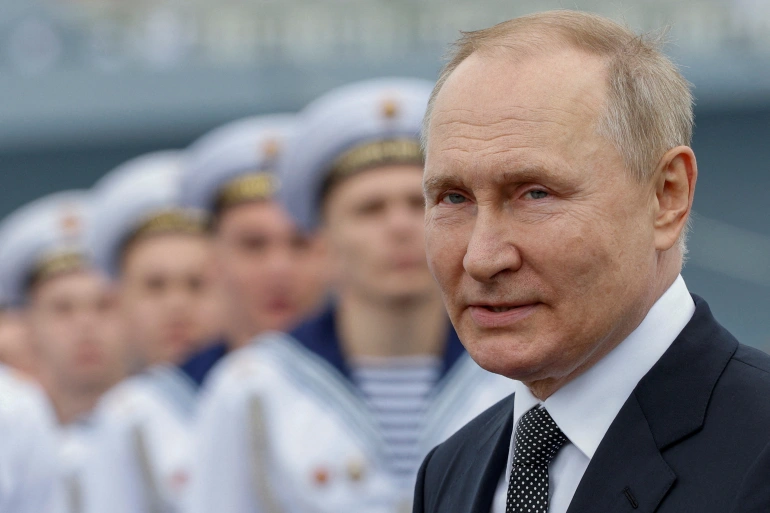Russia began its invasion of Ukraine on February 24 this year. As early as eight months have passed, CNN distributed the article “Russia is bruised as winter approaches. Can Ukraine land another blow?” on October 14.
Is it Ukraine or Russia that will benefit from the arrival of a harsh winter season?

Winter will soon be upon Ukraine. As such, CNN notes that there will likely be fierce fighting between Ukrainian and Russian forces in the coming weeks.
With the cold months nearing and likely bringing a slowdown in ground combat, experts say the next weeks of the war are now expected to be vital, and another With the cold months nearing and likely bringing a slowdown in ground combat, experts say the next weeks of the war are now expected to be vital, and another potential spike in intensity looms over Ukraine as each side seeks to strike another blow.
What is the “another kind of blow” mentioned in the text? The outmatched Russian military is mounting an onslaught on Ukraine’s energy-related infrastructure, using missiles and other means.
If Ukraine and the West are unable to secure the energy they need for the winter, will the power relationship with Russia change, and will a ceasefire become a reality? The reporter in charge of the story said, “That’s why the Ukrainian winter has been so hard.
The Ukrainian winter is that severe. Neighboring Russia has a history of repelling invaders with its ‘General Winter’ many times. The cold weather makes it impossible for enemy forces to advance, and they destroy themselves because they cannot secure sufficient supplies. Many observers are watching to see whether the arrival of a harsh winter will work to Ukraine’s or Russia’s advantage.
General Winter in Ukraine
Two of the most famous wars in which General Winter raged were the “Battle of Russia in 1812” by Napoleon I of the French Empire (1769-1821) and the “Battle of Germany and the Soviet Union (1941-1945)” by Nazi Germany.
The French and German armies made a great advance in the summer, but in the winter, the mud, snow, and cold made it impossible for them to advance at all. During the Russo-German War, the Germans were within striking distance of the Kremlin Palace in Moscow, but their weapons were frozen in the cold. However, the cold weather froze their weapons, and they were unable to replenish their supplies, which greatly weakened the morale of the army and ultimately allowed the Soviet forces to counterattack.
And General Winter’s fury was not limited to Russia. Temperature data shows that winters in Russia and Ukraine are extremely similar.
In Leningrad, where the Germans and Soviets fought to the death, and now St. Petersburg, the average minimum and maximum temperatures range between minus 9 and minus 2 degrees Celsius during the harsh winter months. Khiu, the capital of Ukraine, also ranges between minus 6 and 0 degrees Celsius, indicating that both Russia and Ukraine are the home of “General Winter””.
Tanks moving even in winter
Let’s also take a look at the climate in the south, just in case. The average temperature in Herson, the capital of Herson Oblast, where the fierce battles in the Russo-Ukrainian war are taking place, ranges between minus 6 degrees Celsius and plus 3 degrees Celsius.
It is said that “for every meter of wind speed, the temperature is said to drop by one degree Celsius. It is no wonder that during the harsh winter season, the winds at the front lines in Ukraine can blow the temperature above minus 10 degrees Celsius. In such cold weather, it is impossible for soldiers to engage in operations, no matter how much state-of-the-art winter clothing they wear.
However, military critic Yukio Kikuchi points out, “I doubt that the arrival of General Winter will really bring the battle lines to a standstill.
“I think the Western and Japanese media may be assuming too much that ‘both armies are incapable of fighting during the harsh winter months. For example, in Ukraine, it rains continuously in autumn. The vast land becomes a quagmire, and even caterpillar-powered tanks cannot move freely. During the autumn rains, the battle lines would certainly be at a standstill. But in winter, the ground freezes over. At least the tanks will be able to move.”
Leading NATO Forces
Let us once again look back at the early stages of the Russian-Ukrainian war. The Russians initially marched north toward the capital of Khiu, east toward Halkhiu, and south toward Herson.
The Ukrainian army intercepted the Russians in accordance with the “textbook” strategy. In short, they defended, defended, defended, and then counterattacked. However, it is needless to say that this was a strategy that was easier said than done.
The military history of the former Japanese military shows how difficult it was to defend against an attack and then turn to a counteroffensive.
At the end of the Pacific War, the Japanese military lost Saipan, Iwo Jima, and Okinawa one after another. And they were never able to mount a counteroffensive.
As to why the Ukrainian forces were able to repel the Russians and move to pursue, Kikuchi says, “It was probably because NATO (North Atlantic Treaty Organization) forces provided generous operational support.
It has been reported many times that Western nations have provided Ukraine with the latest weaponry and sensitive information via reconnaissance satellites and other means. Not only that, but NATO forces must be providing close operational guidance to the Ukrainian military. Otherwise, they would not have been able to mount such a successful counterattack.
Waste of Ammunition
It is generally said that “the offensive side needs four times more troops than the defensive side.
At the beginning of the war, the Ukrainian army numbered approximately 200,000 men, while the Russian army numbered approximately 900,000, more than four times as many. Although it is unknown whether the Russian army was able to adequately supply its 900,000 troops, it is undeniable that the Ukrainian army could have been defeated if the Russians had concentrated their forces in one of the three directions (north, east, or south). (Mr. Kikuchi)
The attack from three directions certainly forced the Russians to disperse their forces. However, the same must have been true for the Ukrainian forces that intercepted them.
Why were the Russian forces, which had secured a numerical superiority, repulsed by the Ukrainian forces?
It is estimated that if Russian forces invaded Hokkaido, the SDF would need 400,000 tons of ammunition in one month. And the attackers would need even more firepower than the defenders. The Russian army, by advancing from three directions, consumed ammunition at a furious rate,” said Kikuchi.
The more the Ukrainian army put up a good fight, the less and less ammunition the Russian army had. And the Russian army, which lacked firepower, allowed the Ukrainian army to mount a counteroffensive, prolonging the war. It is not hard to imagine that this caused the Russian army to run out of ammunition.
Infantry Unnecessary
Incidentally, on October 25, CNN (Japanese and electronic editions) distributed an article titled “Former Russian President Denies Reports of ‘Weapons Shortage.
The article reported that former Russian President Dmitry Medvedev (57) issued a statement saying that “production of weapons and equipment for the Russian military is increasing,” but few Western experts seem to believe this.
The Russian military has run out of guided missiles as well as regular ammunition and is losing tanks and bombers one by one.” This would be a great opportunity for the Ukrainian military to launch an offensive. With the arrival of General Winter, it may indeed be difficult for infantry to engage in operations. The role of the armored divisions is to kick out enemy forces with tanks and to occupy enemy territory with infantry. Tanks and infantry are equally important, but there should be no need to be bound by theories now,” said Kikuchi.
Tanks can fight even in severe winters. The Ukrainian army can advance only with tanks and destroy Russian tanks and positions.
Even if it is difficult for the Ukrainian soldiers to retake the occupied territories, they can inflict enormous damage on the Russian army. I don’t think the Ukrainian army will miss such an opportunity. Even if winter comes, tank units will probably continue to attack the Russian army with the support of artillery.
Unrealistic “Great Wall of China
On October 22, CNN reported “Mercenary group Wagner builds anti-tank defense facility, satellite images show.
According to the article, “The article said that a private Russian war company, Wagner, is building an anti-tank defense facility in the eastern city of Hirske. It is two kilometers long, lined with pyramids made of cement, and is believed to be aimed at blocking tanks from driving. Trenches have also been set up, probably with the intention of destroying the stuck tanks.
Some Russian media reported that defensive facilities are planned to be built from Hilske to the southern part of the country to a town called Svitlodarsk.
At the end of the article, CNN wrote, “If a defensive facility of this length is built, its total length will be about 217 kilometers. The article must have ridiculed the impracticality of building such a “Great Wall of China.
Even if long-range anti-tank defenses were built, they would be useless without soldiers to defend them. Morale in the Russian army is low, and desertions seem to be rampant. There are reports that new recruits are being forcibly mobilized and sent to the front lines without proper training. There are few Russian soldiers defending the defensive facilities that Wagner has built, and it is quite possible that the Ukrainian army will break through easily,” said Kikuchi.
Defeat without waiting for spring?
If the Ukrainian army launches an onslaught during the winter season, the arrival of General Winter would hinder the Russian army’s supply and could expose it to a further onslaught by enemy forces.
I don’t think we can rule out the possibility of a total collapse of the Russian army in both the east and the south, rather than a stalemate on the battle front during the harsh winter months.” I see the possibility that the Russian army will face defeat without waiting for spring.


コメント